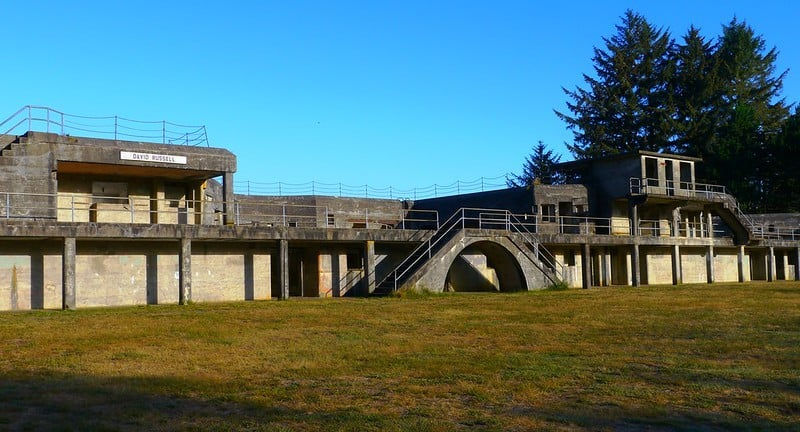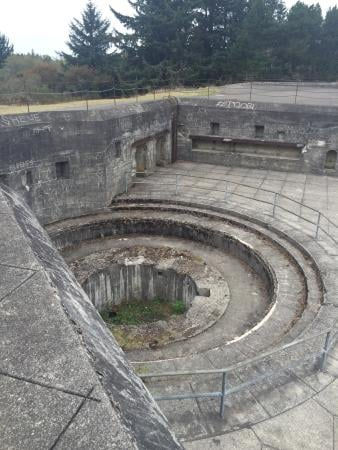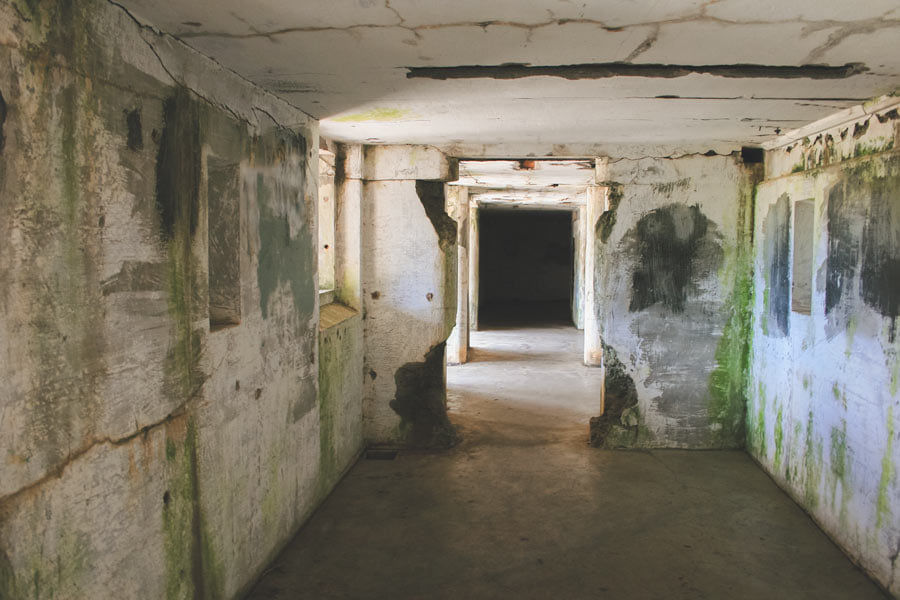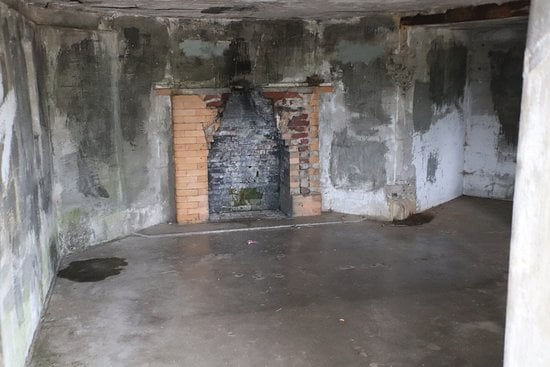Three Historic Artillery Batteries on the Columbia River
- Crazydsadventures
- Sep 24, 2023
- 5 min read
Updated: Sep 24, 2023
In 1862, Cape Disappointment, on the Washington side of the Columbia, was armed with smoothbore cannons to protect the mouth of the Columbia River from enemies. Three years later, in 1865, Fort Stevens, complete with a moat and drawbridge, was established on the Oregon side. In 1875 Fort Canby came into existence to improve the defense of the Columbia. In 1896 Fort Columbia was built and in 1897 Fort Stevens was improved. The mouth of the Columbia River was now protected with three forts.
Fort Stevens boasted eight concrete batteries – including mortars and long and short-range rifled guns. At Fort Stevens, Battery Mishler was the only underground battery and it housed two 10” guns that were open to the sky. Each gun was mounted on a disappearing carriage, which hid the guns behind concrete and earthen walls when not being fired. Each gun was also operated by teams of 35 men who worked efficiently as one unit to fire each massive gun.
Fort Stevens is a 4,300-acre park offering a variety of recreation adventures, including camping, beachcombing, a freshwater lake, trails, wildlife viewing, and an historic shipwreck along with this military battery.


You can also enjoy year-round military displays at the military museum and information center. Visit the only Civil War era earthen fort on the west coast or explore the many turn-of-the-century, concrete artillery gun batteries. Underground tours are available during the summer of a gun battery that served as a World War II command center. For tour information, call the Friends of Old Fort Stevens at 503-861-2000.


The tour takes you past hallways and rooms and interesting features including a massive underground gun pit. The huge gun was mounted atop a large, thick concrete pillar. The underground Battery Mishler guided tours occur on weekends and a ticket reservation is required, along with a daily parking permit.

Fort Stevens was decommissioned after World War II. By 1947, all of the guns had been removed and much of the fort was turned over to the U.S. Army Corps of Engineers, who used the fort as their headquarters "for maintenance activities at the mouth of the Columbia River".
There's little left of Fort Canby today, but it's still interesting to poke around the remains. The fort was heavily armed during the Civil War to prevent Confederate gunboats from entering the Columbia River. Upgraded dramatically during WWII, the fort stood as the principal defender of the river. Although no shots were fired from Fort Canby, a Japanese submarine did manage to penetrate close enough to the Oregon side to fire on Fort Stephens in 1942.

The hike up to Fort Canby is located at the same parking lot to do the Cape Disappointment Lighthouse Hike. Fort Canby trail is to the right and Cape Disappointment Lighthouse is to the left. The hike is about a mile out and back and is pretty steep. It does help that there are a couple of switchbacks to make it a little easier. There is also an upper parking lot close to the Fort and Interpretation center if you want wheelchair accessibility.


I love the trees here and there are a bunch of them that look like this one.



The Lewis and Clark Interpretive Center stands high on the cliffs of Cape Disappointment State Park, 200 feet above the pounding Pacific surf. A series of mural-sized timeline panels guide visitors through the westward journey of the Lewis and Clark Expedition using sketches, paintings, photographs, and the words of Corps members themselves. The center also features a short film presentation, a gift shop, and a glassed-in observation deck with fabulous views of the river, headlands, and sea. Additional displays focus on local maritime and military history.


Fort Canby is within the Lewis and Clark National and State Historical Park. Built in 1864, it was one of the earliest forts in Washington, was named for Major General Edward Richard Canby. An important base in pioneer days, overlooking the Columbia River entrance, it has been deactivated in May of 1947.


Between 1896 and 1908, after a long period of neglect during which the fort and its armament had become obsolete, the Army completely renovated them. New barracks and other buildings were constructed, and two batteries (Batter Harvey Allen and Battery Elijah O'Flying) with a total of five rifled guns in concrete emplacements were installed.


In 1921 a new mortar battery, Battey Guenther, with four 12" mortars was added with the mortars coming from Battery Clark at Fort Stevens.


The fort remained in caretaker status from the end of World War I to 21 Feb 1941 manned only by a sergeant and two enlisted men. The fort was reactivated in 1941 and in 1944 Battery 247 was added on McKenzie Head. In 1947 the fort was deactivated. Present surviving structures date from the World War II period.


Fort Canby was originally named Fort Cape Disappointment in 1864
Fort Columbia was originally called Post at Chinook Point, although there were no fortifications or gun batteries here before 1898. This was a sub-post of Fort Stevens in Oregon. The Columbia River was mined during WWI and WWII, controlled by a mine casemate located here on post. The mine casemate and several fire-control and observation stations still exist. Batteries here are Battery Jules Ord (1898 - 1917) (of which gun #3 was originally named Battery William Neary and now buried), Battery William Murphy (1900 - 1945), Battery 246 (1940's) never armed (present guns came from Fort McAndrew, Newfoundland in 1993), and Battery Frank Crenshaw (1900 - 1920). Became a state park in 1950.
Fort Columbia State Park is considered one of the most intact historic coastal defense sites in the U.S.



Two of the restored buildings are available for rent; these vacation houses are perfect for family reunions and retreats. If you're interested in renting you can call (360) 642-3078. The area has some steep parts but there are a bunch of different parking lots so choose your parking lot wisely.


Constructed between 1896 and 1903, renovated during World War II and de-commissioned in 1947, this day-use park on Chinook Point near the mouth of the Columbia River will take you back to the early 20th Century.



Fort Columbia Historical State Park is a 618-acre, day-use historical park located within Lewis and Clark National and State Historical Park. The park sits along 6,400 feet of freshwater shoreline on the Columbia River. In addition to its historical significance, the area offers bird watching, miles of forested hiking trails and secluded beaches.


You can walk around and explore officers’ homes, artillery batteries and two 6-inch, rapid-fire, World War II-era guns that are among six still in existence.



Fort Columbia is a ghost town in the sense that these days no one lives there, but luckily for all of us it has actually been maintained. Along with the soldiers, there were also bakers, barbers, gardeners and musicians stationed at the fort near the mouth of the Columbia River.



The fort was renovated during World War II, but not long after, it was declared surplus. Fort Columbia was officially decommissioned in 1947 and became the property of the state of Washington in 1950.

I love the tracks in the ceiling, and this is how they use to move artillery around within the battery.




The view of the ocean from here is awesome!!

Although often referred to as an early 20th century site, the history of the land upon which Fort Columbia sits goes back much further. Chinook Point, the setting of this historic fort, is within the accustomed territory of the Chinook Indian Nation and is designated as a National Historic Landmark for its historical significance over three centuries. Meriwether Lewis and William Clark passed through this area as well on January 9th, 1806.
The Chinook Native Americans were first described ethnographically by the American explorers Lewis and Clark in 1805. Because American colonialism severely disrupted Chinook culture, ultimately removing the people to reservations, most information about traditional Chinook life is based on the records of these and other traders and explorers, together with what is known of neighboring groups.
Comments